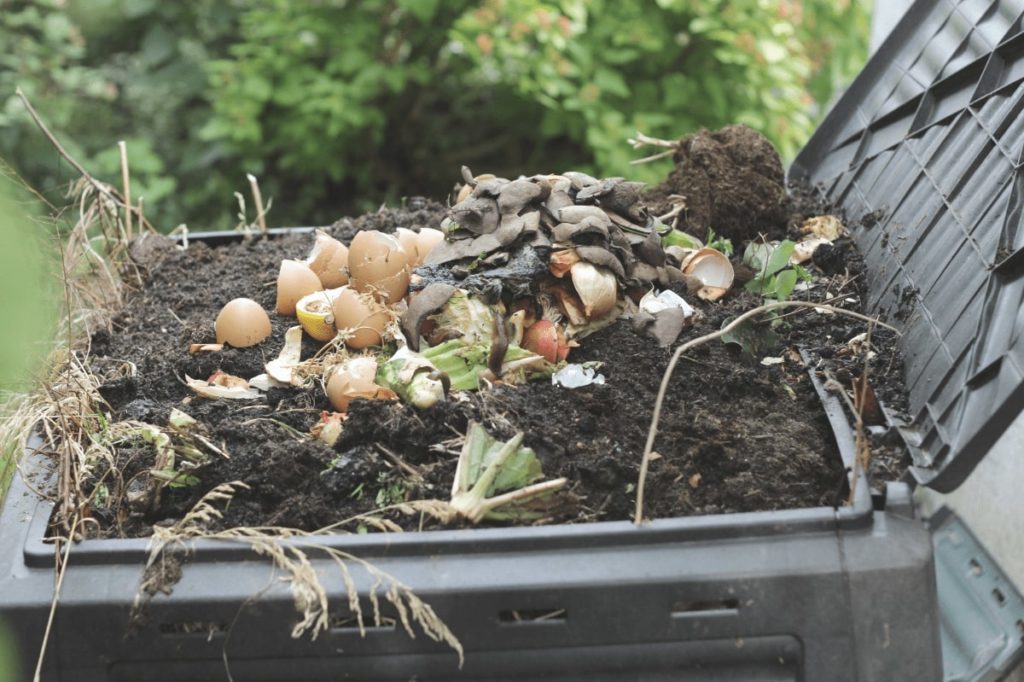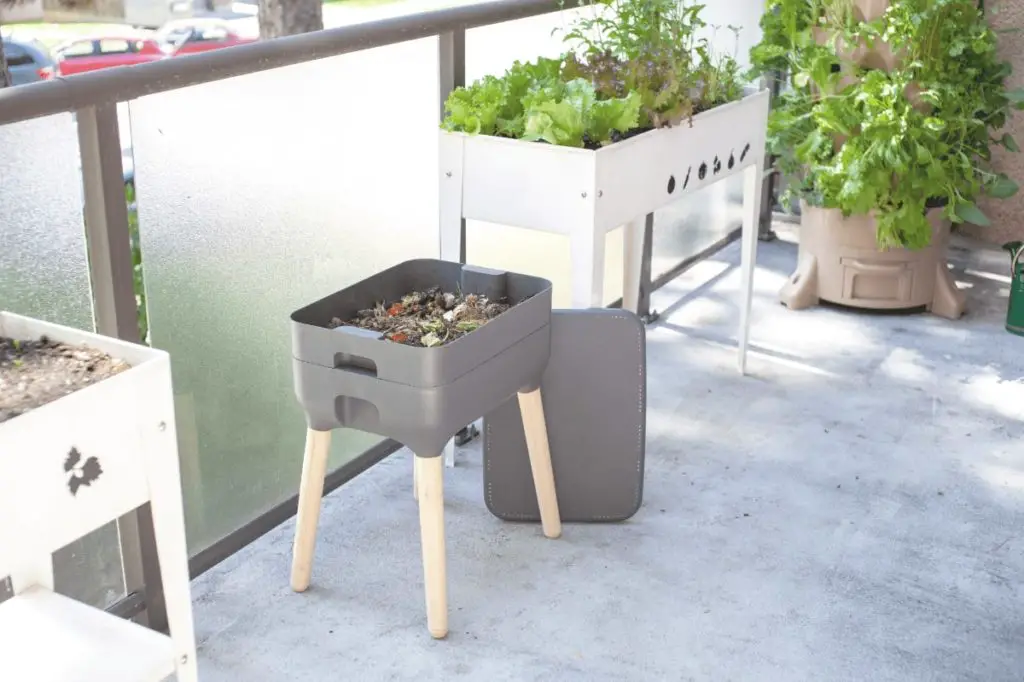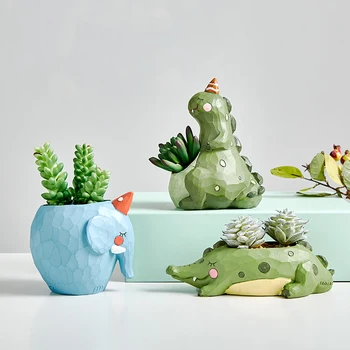Although composting is nearly as old as time itself, there’s no time like the present to learn how to bring this excellent method of reusing and recycling items in your own home.
Composting, which utilizes scraps or other kitchen trash for natural fertilizer that helps enrich the soil, can be intimidating. However, once you get the hang of it, you’ll never look back.
From how to get started to all the details you need to know to make your composting efforts go smoothly, here is your ultimate guide for how to compost at home.
Composting is an efficient and practical alternative to filling trash bags with trash and leftovers and taking them to environmentally harmful landfills. The process behind composting is fascinating, all-natural, and easy!
At its core, composting works by breaking down organic matter through an aerobic process, meaning that air is involved.
With the contribution of air, microorganisms in the soil work to consume wastes that contain carbon, leaving behind other essential building blocks.
A significant component of composting is knowing the difference between organic and inorganic. Although organic is a trendy term that has come to mean food produced naturally without pesticides, it has a much deeper meaning.
Organic material is made up of carbons. This material includes most food wastes, paper-based wastes, and landscaping wastes. When these wastes are dumped into landfills, they undergo an anaerobic process, which decomposes them without air.
From the anaerobic process, organic wastes produce methane, a harmful gas to the environment and fuels climate change. However, simply adding air into the decomposition process changes the outcome drastically.
When air is added, the byproducts of the aerobic composting process are water vapor, carbon dioxide, and earth-enriching, inorganic materials like nitrogen, potassium, and phosphorus. These are common ingredients in many store-bought fertilizers.
So, in a word, composting takes ingredients that, when thrown into a landfill, can lead to climate change and instead takes the same materials to create a soil-enriching compost that you can use around your yard.
Recommended reading: How Does Composting Work?
Composting has become popular from home to home because of all the fantastic benefits it can offer. Consider these crucial ways that composting can simplify your life, reduce your consumption, and help the earth.
First of all, as mentioned before, composting at home prevents your organic waste from going to the landfill, where it contributes to global warming. By composting, you reduce the amount of methane put into the atmosphere, decreasing your carbon footprint.
Secondly, composting is an excellent alternative to store-bought fertilizer. Since it’s all-natural, you won’t have to worry about introducing harmful chemicals to your yard or garden.
Compost replenishes the soil with natural compounds that make it rich, making your produce rich in turn as well.
Also, compost is known for retaining water better than typical garden dirt. Adding a layer of compost to your garden creates a similar effect as mulch: it helps lock in moisture, delivers constant nutrients, and prevents the growth of weeds.
Did you know that while exposing you and your family to chemicals, garden fertilizers are also harmful to the earth? Fertilizer chemicals collect in run-off water and can pollute streams and, inevitably, the ocean as well. Compost keeps water sources clear and unpolluted.
Next, composting can save you both time and money. Although things like plastic trash bags and garden fertilizer may be small costs, they certainly add up over time. Composting eliminates the need for these items.
Fewer trips to the dump or landfill plus less time and effort spent watering your garden will simplify your life and help streamline your daily routine.
Being more self-sufficient by recycling at home also helps boost confidence and satisfaction.
Recommended reading: What Are The Benefits of Composting?
Before you get started with your own home composting, it’s essential to know how to set yourself up for success.
Combining the right ingredients in the right ways, much like cooking in the kitchen, will result in a rich compost that yields all the above benefits.
To facilitate the aerobic decomposition process, four essential elements are needed. These elements are what you’ll need to get your compost heap started: nitrogen, carbon, water, and air.
In your compost recipe, you should balance these elements sufficiently to ensure that the resulting compost is also balanced with the inorganic compounds needed to enrich the soil.
Of course, balancing these four elements means knowing what kind of materials and wastes from around your home fall into each of the categories so that you can add them in the proper amounts.
The first crucial component of compost is carbon. As mentioned before, carbon is essential to the aerobic decomposition process because it is what the microorganisms feed on to help break down the waste.
Wastes high in carbon are considered brown wastes. Brown material is vital for ensuring proper airflow in your compost pile because they are often the bulkier waste items. This waste can include paper products, straw, or any woody material in small or shredded pieces.
However, on their own, brown wastes won’t decay quickly because they don’t hold enough water. To up the moisture content of your compost pile to aid in the timely decomposition process, you need green wastes.
Green wastes are those that are high in nitrogen. Because of their nitrogen content, these materials will decompose quickly. Green materialwaste includes most kitchen food scrap,coffee grounds, grass clippings, or other yardgreen trimmings from your garden.
If added alone or in amounts out of balance, green wastes will become stinky as they rot due to all the moisture they hold. When balanced out with brown wastes, however, the smell is combatted and lessened.
Green wastes, as mentioned before, also add moisture to the compost pile, which is just essential as good airflow. Wet conditions help give the microbes in the soil the best possible environment for breaking down the organic materials.
While green wastes will help increase the moisture of your compost pile, you may need to add extra water in dry or hot seasons, like summer.
While you can add many of your kitchen and outdoor wastes to your compost to help create the best end product, some items should be disposed of differently, as they can interfere negatively with the conditions necessary for proper decomposition.
Consider the end product when leaving pet waste out of your compost. Since you’ll be using it around your home, the experience will be far more pleasant without the smell of pet waste, which can also, in some cases, be hazardous to your health.
Plastics and inorganic materials don’t break down in the same way and through the same processes as organic materials. Plastics release chemicals as they decompose, which will harm your compost.
Steer clear of plastics advertised as compostable as well. These plastics are meant to be decomposed industrially and not in a home compost pile.
Likewise, glossy paper often has a plastic content and should not be composted. Colored paper and any kind of thick or coated paper can have foil and other materials that cannot be composted.
While plants are about as organic as it gets, diseased ones can introduce pests and unwanted fungi that can alter the conditions of your compost pile, thereby hindering the microbes from doing their essential work.
Although meat and milk are prevalent kitchen waste items, it’s best to leave them out of your compost pile.
Leaving them out is not because they aren’t biodegradable, but because they can attract pests or scavengers that can ruin your compost pile and make a massive mess in the process!
Recommended reading: Compost Recipe
Now that you have the basics of composting down, it’s time to start figuring out how to integrate the best composting into your life.
There are several different methods and tools that you can choose to help you make composting a feasible and beneficial way of life.
All of the different composting styles offer various benefits and varying ranges of effort and drawbacks. The key is finding the method that best fits your lifestyle and needs.
Many find that they prefer to utilize multiple types of composting by having several different kinds of piles going at once. Doing this can maximize efficiency by increasing your compost output and upping your recycling abilities.
These two most popular compost forms each have two related methods, so there’s a good option for everyone.
Factors to Consider | Backyard Composting | Apartment Composting | ||
Compost Tumbler Method | Pit or Trench Composting | Vermicomposting | Bokashi Composting | |
Space needed | Yard space or small outdoor area | Small outdoor area or indoor area | ||
Materials to compost with | Green and brown material; a ratio of 1:1; includes kitchen scraps, yard waste, etc. | Kitchen scraps, paper products; a ratio of 70:30 brown to green waste. | ||
Required effort | Must be turned every 3–4 days; higher effort | Low effort, must be uncovered and covered every use | Low maintenance; material must be added regularly; an average of 30 minutes upkeep per week | |
Expected process time | As early as 2-6 weeks | From 6 months to 1 year | From 3-6 months | From 6-8 weeks for the whole process |
Backyard composting is perfect for those who have adequate space in their yards for containing a compost bin or pile.
This method also serves people with landscaping and gardens well as it makes use of yard waste, such as grass clippings and shredded wood material.
Backyard composting can also take more maintenance because it deals with a more significant amount of material. However, backyard composting can differ between the two methods of tumbler and pit or trench composting.

This popular composting method utilizes a tumbler that you can install in a smaller amount of yard space. Although it’s not open to the air, a handle allows the user to turn the whole heap, ensuring proper airflow.
Because the pile will need to be turned regularly, this method is best for those who don’t mind tending to their compost bin often.
However, the turn-around time is decent, and this method helps keep the compost contained and from becoming an eyesore.
In pit or trench composting, the compost is compiled in a hollow or trench and then covered with grass clippings or straw. This method utilizes the surrounding dirt and earthworms to help facilitate decomposition.
However, although it is a low-effort method, it will take about twice as long as the tumbler method to decompose fully.
Because of this, it’s a suitable method for gardeners who know ahead of time how much rich soil they will need and where it will go.
*Optional (to protect soil layer): add “brown” material over “greens” before covering the hole with soil.
Recommended reading: Backyard Composting 101– A Beginner’s Guide
Even if you don’t have a lot of yard space, you can still enjoy the benefits of the indoor composting process through methods that require very little space.

In this method, worms help speed up the composting process, making this a low-effort and low-maintenance option.
For vermicomposting, you’ll need a worm box and worm. Red Wiggler worms are a popular and highly efficient choice that can help churn out good compost in as little as two weeks.
For bokashi composting, although not technically accurate composting, it’s trendy because you can do it indoors. It includes using a bucket system to reduce food waste and recycle it into usable, rich soil.
The main difference is that composting breaks down the organic matter, while Bokashi buckets ferment it. Either way, it’s a low-maintenance method that’s great for people who don’t have a lot of space for a compost bin.
Recommended reading: How to Compost in an Apartment – A Beginner’s Guide
Once you’ve collected the right ingredients, selected the method that works for you, and added it to your compost heap, the hard part is over!
The most rewarding part comes when you can use the finished product around your yard. Here’s how to use your finished compost to enrich your garden and beautify your yard.
Like any other lifestyle change, acclimating to composting won’t be immediate. However, there are some things you can do to help you transition well to this more earth-friendly and beneficial way to handle wastes.
Especially for families, including lists with pictures of what items can be composted and which ones can’t help shorten the learning curve. Keep a stainless steel bowl on the counter where everyone can see it to remind them to add compostable material to the bowl instead of the trash can.
Helping your family adjust to composting is rewarding, and instilling the idea of recycling and caring for the earth at a young age is essential to helping your kids become wise consumers and do their part to help care for the planet.
Engage your children in the end product of composting to allow them to take part in the satisfying reward of their work.
Spreading the compost in the garden and watching it enrich organic vegetables in the garden is a great way to see the cause and effect of the green changes you make around your home.
Composting can seem intimidating if you’ve never tried it before, but it doesn’t have to. Now that you know how to compost at home, you’re ready to give it a try!
Once you experience the benefits of saving time and money as well as the satisfaction of being self-sufficient and helping take care of the earth, you’ll never go back totingback to toting trash to the landfill again!





We provide a platform supported by gardening enthusiasts to share unique experience and knowledge.
We’ve pledged 5% of sales to the program which help more families have opportunity to have garden.
Every action we make has an impact on planet. Learn more about Million Compost Movement.
Join facebook community to connect, share passion and get support when you need.
Keep in mind that we may receive commissions when you click our links and make purchases. However, this does not impact our reviews and comparions. We try our best to keep things fair and balanced, in order to help you make the best choice for you.
As an Amazon Associate, we earn from qualifying purchases.
Sign up for gardening tips, activism awareness, exclusive offers and more!
© Garden Guidepost

Gardening tips, activism awareness, exclusive offers and more!